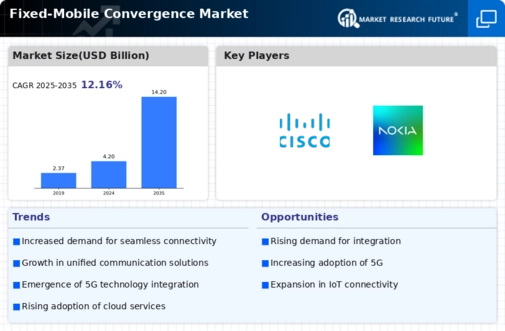Market Trends
Key Emerging Trends in the Fixed Mobile Convergence Market
The use of Fixed-Mobile Convergence (FMC) is becoming more widespread in the telecommunications industry, especially among integrated operators who own both fixed and mobile networks. These operators are eager to explore the advantages of FMC to save costs and boost revenues. FMC involves creating a unified network, utilizing the IP Multimedia Subsystem (IMS) core control architecture. This convergence is anticipated to help operators in reducing their operational costs.
One of the key benefits of IMS-based FMC services is the flexibility it provides to operators in choosing networks and terminals. This flexibility assists them in meeting their operational requirements effectively. Additionally, it empowers mobile, fixed, and full-service network operators to enhance their capabilities for long-term development and efficiently implement transformations when introducing new services. FMC-enabled services, such as pervasive access and new value-added services, are predicted to bridge the revenue gap for telecommunication operators.
Implementing FMC is also expected to have positive effects on customer retention. By offering bundled services that include voice, video, and messaging, FMC can reduce the churn rate and enhance the overall user experience. This shift towards FMC infrastructure is driven by the desire to benefit from these advantages.
When considering the operational expenditure (OPEX) for integrated operators, it can be broadly categorized into three groups:
Network-related costs: This includes expenses associated with the operation, maintenance, and repair of the network, as well as software licensing.
Marketing and sales costs: These encompass expenditures related to marketing efforts and customer retention strategies.
Costs related to IT and related services: This involves expenses for designing and developing new services.
By utilizing FMC services, operators aim to improve customer loyalty, ultimately leading to an increase in overall revenue. The seamless integration of fixed and mobile networks provided by FMC allows operators to optimize their costs across these categories.
The attractiveness of FMC lies in its ability to offer a unified platform that streamlines operations and supports a variety of services. As a result, operators are increasingly adopting FMC to stay competitive in the evolving telecommunications landscape. The growth of the overall market is expected to be fueled by the rising preference for FMC services among operators who recognize the potential for cost savings and revenue generation.

















Leave a Comment